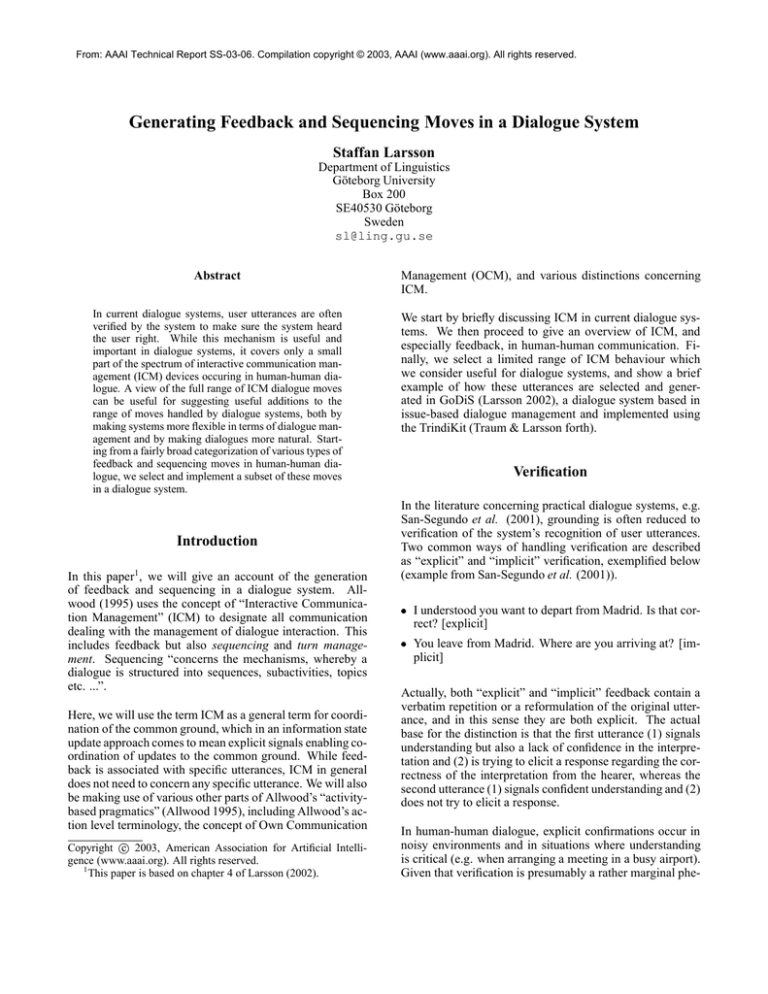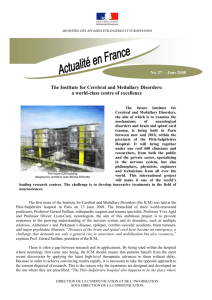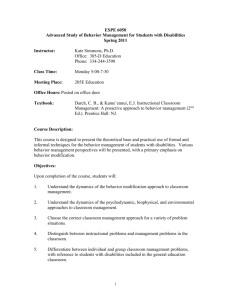
From: AAAI Technical Report SS-03-06. Compilation copyright © 2003, AAAI (www.aaai.org). All rights reserved.
Generating Feedback and Sequencing Moves in a Dialogue System
Staffan Larsson
Department of Linguistics
Göteborg University
Box 200
SE40530 Göteborg
Sweden
sl@ling.gu.se
Abstract
Management (OCM), and various distinctions concerning
ICM.
In current dialogue systems, user utterances are often
verified by the system to make sure the system heard
the user right. While this mechanism is useful and
important in dialogue systems, it covers only a small
part of the spectrum of interactive communication management (ICM) devices occuring in human-human dialogue. A view of the full range of ICM dialogue moves
can be useful for suggesting useful additions to the
range of moves handled by dialogue systems, both by
making systems more flexible in terms of dialogue management and by making dialogues more natural. Starting from a fairly broad categorization of various types of
feedback and sequencing moves in human-human dialogue, we select and implement a subset of these moves
in a dialogue system.
We start by briefly discussing ICM in current dialogue systems. We then proceed to give an overview of ICM, and
especially feedback, in human-human communication. Finally, we select a limited range of ICM behaviour which
we consider useful for dialogue systems, and show a brief
example of how these utterances are selected and generated in GoDiS (Larsson 2002), a dialogue system based in
issue-based dialogue management and implemented using
the TrindiKit (Traum & Larsson forth).
Introduction
In this paper1, we will give an account of the generation
of feedback and sequencing in a dialogue system. Allwood (1995) uses the concept of “Interactive Communication Management” (ICM) to designate all communication
dealing with the management of dialogue interaction. This
includes feedback but also sequencing and turn management. Sequencing “concerns the mechanisms, whereby a
dialogue is structured into sequences, subactivities, topics
etc. ...”.
Here, we will use the term ICM as a general term for coordination of the common ground, which in an information state
update approach comes to mean explicit signals enabling coordination of updates to the common ground. While feedback is associated with specific utterances, ICM in general
does not need to concern any specific utterance. We will also
be making use of various other parts of Allwood’s “activitybased pragmatics” (Allwood 1995), including Allwood’s action level terminology, the concept of Own Communication
­
Copyright c 2003, American Association for Artificial Intelligence (www.aaai.org). All rights reserved.
1
This paper is based on chapter 4 of Larsson (2002).
Verification
In the literature concerning practical dialogue systems, e.g.
San-Segundo et al. (2001), grounding is often reduced to
verification of the system’s recognition of user utterances.
Two common ways of handling verification are described
as “explicit” and “implicit” verification, exemplified below
(example from San-Segundo et al. (2001)).
I understood you want to depart from Madrid. Is that correct? [explicit]
You leave from Madrid. Where are you arriving at? [implicit]
Actually, both “explicit” and “implicit” feedback contain a
verbatim repetition or a reformulation of the original utterance, and in this sense they are both explicit. The actual
base for the distinction is that the first utterance (1) signals
understanding but also a lack of confidence in the interpretation and (2) is trying to elicit a response regarding the correctness of the interpretation from the hearer, whereas the
second utterance (1) signals confident understanding and (2)
does not try to elicit a response.
In human-human dialogue, explicit confirmations occur in
noisy environments and in situations where understanding
is critical (e.g. when arranging a meeting in a busy airport).
Given that verification is presumably a rather marginal phe-
nomena in human-human dialogue, it is perhaps surprising
that it is often the only aspect of feedback covered in dialogue systems literature. Firstly, because it is usually not
necessary for humans to verify what they (think they) have
heard; that is, it is a rather uncommon grounding procedure
in human-human dialogue. Second, because it only involves
part of the full spectrum of feedback behaviour, excluding
e.g. acceptance-related feedback behaviour.
Of course, verification of user utterances are of central importance in dialogue systems, given the quality of current
speaker-independent speech recognition. This explains to
some extent why verification is often the only aspect of feedback handled by current systems - it is simply necessary.
However, this is no reason not to explore further the possible uses of a wider range of feedback behaviour in dialogue
systems.
Feedback and related behaviour in
human-human dialogue
By feedback we mean behaviour whose primary function
is to deal with grounding of utterances in dialogue2. This
distinguishes feedback from behaviour whose primary function is related to the domain-level task at hand, e.g. getting
price information. Non-feedback behaviour in this sense includes asking and answering task-level questions, giving instructions, etc. (cf. the “Core Speech Acts” of Poesio &
Traum (1998)). Answering a domain-level question (e.g.
saying “Paris” in response to “What city do you want to
go to?”) certainly involves aspects of grounding and acceptance, since it shows that the question was understood and
accepted. However, the primary function of a domain-level
answer is to resolve the question, not to show that it was
understood and accepted.
To get an overview of the range of explicit feedback behaviour that exists in human-human dialogue, we will classify feedback according to four criteria. We will assume
that DP has just uttered or is uttering to DP , when the
feedback utterance (uttered by to ) occurs.
level of action / basic communicative function (contact,
perception, understanding, reaction / acceptance)
polarity (positive / negative / neutral): whether indicates
contact / perception / understanding / acceptance or lack
thereof
eliciting / non-eliciting: whether is intended to evoke a
response (e.g. a reformulation or a reason to accept some
content)
form of : single word, repetition etc.
content of : object-level or meta-level
2
Since this paper is not concerned with multimodal dialogue,
we will only discuss verbal feedback.
The action level criterion has been explained above; the others will be explained presently. The criteria of basic communicative function, polarity, eliciting/non-eliciting, and surface form are all derived from Allwood, Nivre, & Ahlsen
(1992) and Allwood (1995).
Levels of action in dialogue
Both Allwood (1995) and Clark (1996) distinguish four levels of action involved in communication ( is the speaker of
utterance , is the hearer/addressee). They use slightly
different terminologies; here we use Allwood’s terminology
and add Clark’s (and, for the reaction level, also Ginzburg’s)
corresponding terms in parenthesis. The definitions are
mainly derived from Allwood.
Reaction (acceptance, consideration): whether has integrated (the content of) Understanding (recognition): whether understands Perception (identification): whether perceives Contact (attention): whether and have contact, i.e. if
they have established a channel of communication
Given that grounding is concerned with all levels, it follows
that grounding-related feedback may concern any (and possibly several) of these levels.
We can make further distinctions between different levels
of understanding, corresponding to three levels of meaning.
These sublevels give a finer grading to the level of understanding. (A similar distinction is also used by Ginzburg
(forth)).
domain-dependent and discourse-dependent meaning
(roughly, “content” in the terminology of Barwise & Perry
(1983) and Kaplan (1979))
– referential meaning , e.g. referents of pronouns, temporal expressions
– pragmatic: the relevance of in the current context
discourse-independent (but possibly domain-dependent)
meaning (roughly corresponding to “meaning” in the terminology of Barwise & Perry (1983) and Kaplan (1979)),
e.g. static word meanings
By “discourse-independent” we mean “independent of the
dynamic dialogue context” (modeled in GoDiS by the information state proper). However, discourse-independent
meaning may still be dependent on static aspects of the activity/domain. It is obvious that these levels of meaning are
intertwined and do not have perfectly clear boundaries. Nevertheless, we believe they are useful as analytical approximations.
Positive, negative, and neutral feedback
interrogative
Positive feedback indicates one or several of contact, perception, understanding, and integration, while negative feedback indicates lack thereof.
While there are clear cases of positive (“uhuh”, “ok”) and
negative (“pardon?”, “I don’t understand”) feedback, there
are also some cases which are not so clear. For example,
are check-questions (e.g. “To Paris?” in response to “I want
to go to Paris”) positive or negative? If positive feedback
shows understanding, and negative feedback lack of understanding, then check-questions are somewhere in between;
they indicate understanding but also that the lack of confidence in that understanding.
Here we will assume a third category of neutral feedback
for check-questions and similar feedback types. If negative
feedback indicates a lack of understanding, neutral feedback
indicates lack of confidence in one’s understanding.
Negative feedback can be caused by failure to integrate
on any of the levels of action in dialogue:
lack of contact - H did not notice that S said something
lack of perception - H did not hear what S said
lack of understanding on a semantic/pragmatic level - H
recognized all the words, but could not extract a content
– context-independent meaning, e.g. word meanings
– context-dependent meaning, e.g. referents
– pragmatic meaning, i.e. the relevance of S’s utterance
in relation to the context
rejection of content
Eliciting and non-eliciting feedback
We will use the term “eliciting feedback”, borrowed from
(Allwood, Nivre, & Ahlsen 1992), to refer to feedback utterances intended to elicit a response, or more specifically
utterances ¼ such that ¼ is intended to make respond to
¼ because is not sure about how to interpret ’s utterance
. Check-questions (both y/n- and alternative-questions) are
seen as eliciting feedback in this sense. Eliciting feedback
can also occur after ’s utterance is finished.
Form of feedback
– y/n-question (“Did you say ‘Paris’?”, “Do you want to
go to Paris?”)
– wh-question (“What did you say?”, “What do you
mean?”, “Where do you want to go?”)
– alternative-question (“Did you say ‘Paris’ or ‘Ferris’?”,
“Do you want to go to Paris, France or Paris, Texas?”)
ellipsis (“Paris?”, “to Paris.”)
conventional (“Pardon?”)
Apart from showing the speaker that one has understood,
feedback in the form of an explicit declarative report, repetition or reformulation has the additional function of making
sure that the understanding is actually correct, by providing
a chance for correction. A y/n-question has a similar function, but it indicates less confidence in the interpretation (i.e.
is more neutral) and has a stronger eliciting element than
an assertion; a question requires an answer, while an assertion can often be assumed to be accepted in the absence of
protest.
A related dimension of classification is how the form of the
feedback utterance relates to the previous utterance. One
way of giving positive feedback is to simply repeat verbatim the previous utterance (e.g. “To Paris.” in response to
“To Paris.”). A similar strategy is to provide a reformulation
(e.g. “Your destination city is Paris, the capital of France.”).
The latter is perhaps a stronger signal of understanding then
the former, since a verbatim repetition does not in principle
require that the utterance was understood.
Meta-level and object-level feedback
A final distinction can be made depending on whether the
feedback explicitly talks about what the speaker said or
meant, in which case the feedback can be said to be metalevel feedback, or if instead it talks about the subject matter of the dialogue, in which case we talk about object-level
feedback.
Meta-level
– perception (“Did you say ‘Paris’?”)
– understanding (“Did you mean that you want to go to
Paris?”)
Object-level (“Do you want to go to Paris?”)
As with all utterances, feedback utterances can have various
syntactic forms:
declarative (“I heard you say ‘go to Paris’.”, “You want to
go to Paris.”)
imperative (“Please repeat.”)
This distinction does not necessarily apply to all kinds of
feedback. For example, for conventional phrases like “Pardon?” and elliptical phrases like “Paris?” it is not clear if
they refer to what the speaker said or meant, or about the
subject matter of the dialogue, or neither.
Feedback in GoDiS
In this section, we first show how feedback dialogue moves
in GoDiS are represented. We then review the full range
of feedback moves, starting with system-generated feedback
and then moving on to user feedback.
The general notation for ICM dialogue moves used in
GoDiS is the following:
icm: :
where is an action level,
arguments.
is a polarity, and are
: action level
– con: contact (“Are you there?”)
– per: perception (“I didn’t hear anything from you”, “I
heard you say ’to Paris”’)
– sem: semantic understanding (“I don’t understand”,
“To Paris.”)
– und: pragmatic understanding (“I don’t quite understand”, “You want to know about price.”)
– acc: acceptance/reaction (“Sorry, I can’t answer questions about connecting flights”, “Okay.”)
: polarity
– neg: negative
– int: interrogative
– pos: positive
: arguments
Note that the “neutral” polarity has been replaced by the label “int”; we have made a simplifying assumption that neutral feedback is always eliciting and interrogative.3
The arguments are different aspects of the utterance or move
which is being grounded, depending action level:
for per-level: , the recognized string
for sem-level: , a move interpreted from the utterance
for und-level: , where
– Participant is the DP who performed the utterance
– Proposition is the propositional content of the utterance
for acc-level: Proposition, the content of the utterance
3
Note, however, that if we had included feedback forms like
“What did you say?”, this would still be regarded as negative feedback. The “int” label only refers to check-questions, which are
usually y/n-questions. This is arguably not an optimal labelling
convention.
For example, the ICM move icm:undpos:usrdestcity(paris) provides positive feedback regarding a user utterance that has been understood as meaning that the user
wants to go to Paris.
System feedback to user utterances in GoDiS
The fact that speech recognition is much harder for machines
than for humans may motivate different grounding strategies
for handling system utterances than for handling user utterances. In GoDiS, the focus is on the system’s capabilities for
generating feedback in reaction to user utterances. However,
the system is also able to react appropriately to a limited
range of user feedback, as will be seen in the next section.
For user utterances, GoDiS will be able to produce e.g. the
following kinds of feedback utterances (for the examples,
assume that the user just said “I want to go to Paris”):
contact
– negative; icm:conneg (“I didn’t hear anything from
you”)
perception
– negative; icm:perneg realized as fb-phrase (“Pardon?”, “I didn’t hear what you said.”)
– positive; icm:perpos: realized as metalevel
verbatim repetition (“I heard ‘to paris’ ”)
understanding (semantic)
– negative; icm:semneg realized as fb-phrase (“I don’t
understand.”)
– positive; icm:sempos: realized as repetition/reformulation of content (object-level) (“Paris.”)
understanding (pragmatic)
– negative; icm:undneg realized as fb-phrase (“I don’t
quite understand.”)
– positive; icm:undpos: realized as repetition/reformulation of content (object-level) (“To
Paris.”)
– interrogative; icm:undint: realized as
ask about interpretation (“To Paris, is that correct?”)
integration
– negative
proposition-rejection; icm:accneg: realized as explanation (“Sorry, Paris is not a valid destination city”)
– positive; icm:accpos realized as fb-word (“Okay”)
In addition, GoDiS will be able to reject user questions using
the icm:accneg:issue() move, where : Question as
illustrated below:
U What about connecting flights?
S Sorry, I cannot answer questions about connecting
flights.
We are not claiming that humans always make these distinctions between action explicitly or even consciously, nor that
the link between surface form and feedback type is a simple one-to-one correspondence; for example, “mm” may be
used as positive feedback on the perception, understanding,
and acceptance levels. Feedback is, simply, often ambiguous. However, since GoDiS is making all these distinctions
internally we might as well try to produce feedback which
is not so ambiguous. Of course, there is also a tradeoff in
relation to brevity; extremely explicit feedback (e.g. “I understood that you referred to Paris, but I don’t see how that
is relevant right now.”) could be irritating and might decrease the efficiency of the dialogue. We feel that the current choices of surface forms are fairly reasonable, but testing and evaluation on real users would be needed to find the
best ways to formulate feedback on different levels. This is
an area for future research.
A general strategy used by GoDiS in ICM selection is that
if negative or interrogative feedback on some level is provided, the system should also provide positive feedback on
the level below. For example, if the system produces negative feedback on the pragmatic understanding level, it should
also produce positive feedback on the semantic understanding level.
Sequencing ICM in GoDiS
We believe it is good practice to try to keep the user informed about what’s going on inside the system, at least to
a degree that facilitates a natural dialogue where system utterances “feel natural”. One way of doing this is to produce
ICM phrases indicating significant updates to the information state which are not directly related to specific user utterances.
For GoDiS, we have implemented three types of sequencing
ICM. First, GoDiS will indicate when it is loading a dialogue
plan4 . Second, GoDiS will produce ICM to indicate when
an issue is being reraised (in contrast to being raised for the
first time). Third, GoDiS generates ICM moves for indicating accommodation of questions (similar to plan recognition). This is meant to indicate that some inference has been
performed, and that it has been successful.
The choice of actual wordings for these moves are currently
only based on intuitions; both corpus studies and usability
tests can serve to give a firmer ground to the exact formulation of sequencing moves.
icm:reraise: indicate reraising implicitly (“So, ...”)
icm:reraise:: reraising an issue
ing to the issue of Price.”)
explicitly (“Return-
icm:loadplan (“Let’s see.”)
icm:accommodate (“Alright.”)
User feedback to system utterances in GoDiS
icm:accommodate: (“Alright, you want to know about
”)
For system utterances, GoDiS will react appropriately to the
following types of user feedback:
perception level
– negative; fb-phrase (“Pardon?”, “Excuse me?”, “Sorry,
I didn’t hear you”) interpreted as icm:perneg
A sample dialogue with GoDiS
The dialogue below gives an impression of what feedback
and sequencing capabilities our system handles. The basic
principle for move selection in GoDiS is that utterances may
not raise more than one question. Surface form generation
in GoDiS is template-based.
reaction/acceptance level
– positive; fb-phrase (“Okay.”)
icm:accpos
interpreted as
– negative; issue rejection fb-phrase (“I don’t know”,
“Never mind”, “It doesn’t matter”) interpreted as
icm:accneg:issue
In addition, irrelevant followups to system ask-moves are
regarded as implicit issue-rejections. The coverage of user
feedback behaviour is thus more limited than the coverage
for system behaviour. The main motivation for this is that
system utterances are less likely to be problematic for the
user to interpret than vice versa.
The dialogue has been annotated with ICM dialogue moves.
Although it lies outside the scope of this paper to present the
formalism used in GoDiS for representing semantic content,
it has been included in the ICM move annotation for completeness. We hope the formalism is sufficiently straightforward to be understood by the reader; if not, the content-parts
of the annotation can be ignored.
S Welcome to the travel agency!
U price information please
S Okay.
[icm:accpos] You asked about price.
4
Due to space limitations we will not here go into the internal
workings which trigger sequencing ICM. See (Larsson 2002) for
detailed accounts of these.
[icm:undpos:usrissue(?.price())].
Let’s see.
[icm:loadplan] How do you want to travel?
U pardon [icm:perneg]
S How do you want to travel?
U by plane, london
S By plane, is that correct?
[icm:undint:transport(plane)]
U yes
U London. [icm:sem*pos:london] I don’t quite understand. [icm:undneg] Do you mean to London or from
London?
U to london
S Okay [icm:accpos], to London [icm:und*pos:destcity(london)]. What city do you want to go from?
U lyons
S Sorry, Lyons is not in the database [icm:accneg:deptcity(lyons)]. So, [icm:reraise] What city do you want to go
from?
U paris
S Okay [icm:accpos], to Paris [icm:undpos:deptcity(paris)]. When do you want to travel?
U Do I need a Visa?
S Okay [icm:accpos], you want to know about visa
[icm:undpos:issue(?need-visa)]. What country are you
from?
U Sweden
S Okay, from Sweden. No, you don’t need a visa.
Returning to the issue of price [icm:reraise:?.price()].
So, [icm:reraise] when do you want to travel?
...
U What about connecting flights?
S Sorry, I cannot answer questions about connecting
flights. [icm:acc*neg:issue(?.connecting-flights())]
Conclusions and future research
Starting from a fairly broad categorization of various types
of feedback and sequencing moves in human-human dialogue, we have implemented a subset of these moves in a
dialogue system. We believe that a view of the full range
of ICM behaviour can be useful for suggesting useful additions to the range of moves handled by dialogue systems,
both by making systems more flexible in terms of dialogue
management and by making dialogues more natural.
Our account of grounding and ICM is so far only partial in
coverage; phenomena that remain to be accounted for and/or
implemented include clarification ellipsis, semantic ambiguity resolution, collaborative completions and repair, and
turntaking ICM. While we have included some rudimentary
sequencing ICM, further investigations of the appropriateness and usefulness of these utterances are needed; here,
research on discourse markers (e.g. Schiffrin (1987)) and
cue phrases (e.g. Grosz & Sidner (1986), Polanyi & Scha
(1983), and Reichman-Adar (1984)) can be of great use. We
also want to explore turntaking in asynchronous dialogue
management, and how this relates to turntaking ICM.
We are currently implementing a VCR control application
for GoDiS to enable evaluation and further development of
the system. This application will be reachable by phone and
allow users to program and control a (computerized) VCR
using spoken dialogue.
References
Allwood, J.; Nivre, J.; and Ahlsen, E. 1992. On the semantics and pragmatics of linguistic feedback. Journal of
Semantics 9:1–26.
Allwood, J. 1995. An activity based approach to pragmatics. Technical Report (GPTL) 75, Gothenburg Papers in
Theoretical Linguistics, University of Göteborg.
Barwise, J., and Perry, J. 1983. Situations and Attitudes.
The MIT Press.
Clark, H. H. 1996. Using Language. Cambridge: Cambridge University Press.
Ginzburg, J. forth. Questions and the semantics of
dialogue.
Forthcoming book, partly available from
http://www.dcs.kcl.ac.uk/staff/ginzburg
/papers.html.
Grosz, B. J., and Sidner, C. L. 1986. Attention, intention,
and the structure of discourse. Computational Linguistics
12(3):175–204.
Kaplan, D. 1979. Dthat. In Cole, P., ed., Syntax and
Semantics v. 9, Pragmatics. New York: Academic Press.
221–243.
Larsson, S. 2002. Issue-based Dialogue Management.
Ph.D. Dissertation, Göteborg University.
Poesio, M., and Traum, D. R. 1998. Towards an axiomatization of dialogue acts. In Proceedings of Twendial’98,
13th Twente Workshop on Language Technology: Formal
Semantics and Pragmatics of Dialogue, 207–222.
Polanyi, L., and Scha, R. 1983. On the recursive structure
of discourse. In Ehlich, K., and van Riemsdijk, H., eds.,
Connectedness in Sentence, Discourse and Text. Tilburg
University. 141–178.
Reichman-Adar, R. 1984. Extended man-machine interface. Artificial Intelligence 22(2):157–218.
San-Segundo, R.; Montero, J. M.; Guitierrez, J. M.; Gallardo, A.; Romeral, J. D.; and Pardo, J. M. 2001. A
telephone-based railway information system for spanish:
Development of a methodology for spoken dialogue design. In Proceedings of the 2nd SIGdial Workshop on Discourse and Dialogue, 140–148.
Schiffrin, D. 1987. Discourse Markers. Cambridge: Cambridge University Press.
Traum, D., and Larsson, S. forth. The information state
approach to dialogue management. In Smith, R., and Kuppevelt, J., eds., Current and New Directions in Discourse
& Dialogue. Kluwer Academic Publishers.








